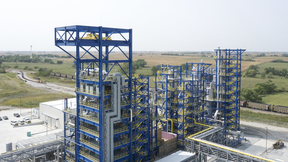Monolith Materials is refining its emissions-free carbon-black production process, which also turns out hydrogen gas
Author of the article: David Booth
Publishing date: Jan 06, 2022 •

Monolith's Olive Creek 1 facility in Hallam, Nebraska PHOTO BY MONOLITH
The U.S. Department of Energy just announced a US$1.04-billion loan guarantee for Monolith Materials, a company that’s designed a clean energy system to split natural gas into hydrogen gas and carbon black. The hydrogen, according to quartz.com , will be used to produce commercial fertilizer. It is the first such loan guarantee from the DoE’s Loan Programs Office since President Joe Biden took office.
Why should you care? Well, for one thing, carbon black is a key ingredient for tires — it accounts for 15 to 20 per cent of modern tires by weight — and Monolith already has a contract with Goodyear for all it produces. Traditional carbon black comes from the combustion of residual oil or coal tar oil — both gross emitters of carbon — but Monolith’s system is virtually emissions-free.
In fact, that’s the biggest news out of this announcement, Monolith claiming that its plasma-based methane pyrolysis process produces no carbon emissions. “We’re a lot like an electric car,” says Rob Hanson, co-founder and CEO of Monolith Materials.
“We have no direct emissions at our plant, but like an electric car, what matters is where your electricity came from.” That’s a significant advancement since most methods of hydrogen production from natural gas have significant carbon footprints.
And the process makes financial sense, too. Hanson says that even without hydrogen, the pyrolysis process — which heats the natural gas without contact with oxygen so the molecules split up into carbon and H2 — is extremely cost-effective: “If all the process did was make carbon black and [we] vented hydrogen, we would still be competitive.” In fact, according to Forbes , Monolith’s original goal was the emissions-free production of carbon black ; hydrogen was the by-product.
This is great news for a hydrogen-fueled infrastructure. One of the condemnations of hydrogen nay-sayers is that production from electrolysis is too expensive for automotive use and so-called “blue” hydrogen isn’t much greener than internal combustion of fossil fuels. If Monolith’s technology proves effective, this could be a leap forward the hydrogen infrastructure has been waiting for…with a nice sideline of reducing the greenhouse gas emitted in the production of car tires.
The U.S. Department of Energy just announced a US$1.04-billion loan guarantee for Monolith Materials, a company that’s designed a clean energy system to split natural gas into hydrogen gas and carbon black. The hydrogen, according to quartz.com , will be used to produce commercial fertilizer. It is the first such loan guarantee from the DoE’s Loan Programs Office since President Joe Biden took office.
Why should you care? Well, for one thing, carbon black is a key ingredient for tires — it accounts for 15 to 20 per cent of modern tires by weight — and Monolith already has a contract with Goodyear for all it produces. Traditional carbon black comes from the combustion of residual oil or coal tar oil — both gross emitters of carbon — but Monolith’s system is virtually emissions-free.
In fact, that’s the biggest news out of this announcement, Monolith claiming that its plasma-based methane pyrolysis process produces no carbon emissions. “We’re a lot like an electric car,” says Rob Hanson, co-founder and CEO of Monolith Materials.
“We have no direct emissions at our plant, but like an electric car, what matters is where your electricity came from.” That’s a significant advancement since most methods of hydrogen production from natural gas have significant carbon footprints.
And the process makes financial sense, too. Hanson says that even without hydrogen, the pyrolysis process — which heats the natural gas without contact with oxygen so the molecules split up into carbon and H2 — is extremely cost-effective: “If all the process did was make carbon black and [we] vented hydrogen, we would still be competitive.” In fact, according to Forbes , Monolith’s original goal was the emissions-free production of carbon black ; hydrogen was the by-product.
This is great news for a hydrogen-fueled infrastructure. One of the condemnations of hydrogen nay-sayers is that production from electrolysis is too expensive for automotive use and so-called “blue” hydrogen isn’t much greener than internal combustion of fossil fuels. If Monolith’s technology proves effective, this could be a leap forward the hydrogen infrastructure has been waiting for…with a nice sideline of reducing the greenhouse gas emitted in the production of car tires.
No comments:
Post a Comment